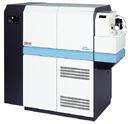|
Instrument Database:
Thermo Scientific - ELEMENT XR
| |
|

|
| |
|
| |
|
| Year of introduction |
2005 |
| Status |
available |
| Company |
Thermo Scientific
|
| Categories |
Mass spectrometer: ICP-MS
|
ELEMENT XR
The linear dynamic detection range is of immense importance in ICP-MS because of the wide range of elements and concentrations to be analyzed in a single analysis.
Product Detail
A unique detection system in ICP-MS, combining a dual mode SEM with a Faraday detector, has been introduced with the Finnigan ELEMENT XR HR-ICP-MS, which is based on the proven design of the ELEMENT2.
Through the combination of a single Faraday collector with the SEM, the linear dynamic range of the ELEMENT XR can be increased by an additional three orders of magnitude, when compared to the ELEMENT2, to over 1012.With this increase in dynamic range, through measurement in Counting, Analog and Faraday detector modes, the maximum measurable concentration achievable with the Finnigan ELEMENT XR is over 1000 µg/g (ppm). Additionally, by moving higher concentration elements into higher resolutions, a further ~ 50-fold increase in measurable concentration can be achieved.
New ELEMENT XR Detection System
Integration of Faraday detector circuit - Sample times of down to 1 ms.
- No decay time required after the measurement of high intensities.
- Automatic switching between SEM (Analog and Counting detection modes) and Faraday with delay times < 1ms.
- Wide cross-over ranges (> 2 orders of magnitude) between different detector modes to allow for accurate, automated cross-calibration.
- Automatic cross-calibration between Faraday and Analog signals.
- Dynamic range: 5 x 107 cps – > 1 x 1012 cps (1 ms sample time).
The ELEMENT2 and the ELEMENT XR can be used as element-specific detectors for speciation analysis when coupled to a chromatographic separation technique like HPLC, CE or GC. Not only metals, but also elements like P, S, F, Cl, Br and I can be detected quasi-simultaneously within each scan.
Due to the high accelerating voltage of 8000V and excellent focusing properties, the Finnigan ELEMENT2 and the Finnigan ELEMENT XR possess sensitivities of > 106 cps/ppb 115In, leading to extremely low limits of detection. Therefore, even low abundant elemental species can be detected.
By using Medium (R=4000) or High Mass Resolution (R=10000), the analyte ions can be completely resolved from polyatomic interferences caused by the mobile phase and/or the sample matrix. This leads to high specificity, low backgrounds and avoids possible misidentification of species not containing the elements of interest.
Fast magnetic scanning and even faster scanning of the electrical field lead to duty cycles (measurement times / measurement times + settling times) of > 90% for full mass range analysis (multi-element speciation with many elements) or > 99.9 % when the elements of interest are within a mass range of 30%. This fast scanning is important for chromatography with many data points per time interval.
The linear dynamic range of > 109 (Finnigan ELEMENT2) resp. >1012 (Finnigan ELEMENT XR) enables accurate detection of low and high abundant elemental species.
There are two application notes available describing the use of the ELEMENT2 for speciation analysis:
- AN30012_E: High Sensitivity Arsenic Speciation: HPLC Sector Field ICP-MS
- AN30076: Simultaneous Phosphorus and Sulfur Speciation by HPLC interfaced with High Resolution ICP-MS
|
Related links:
|